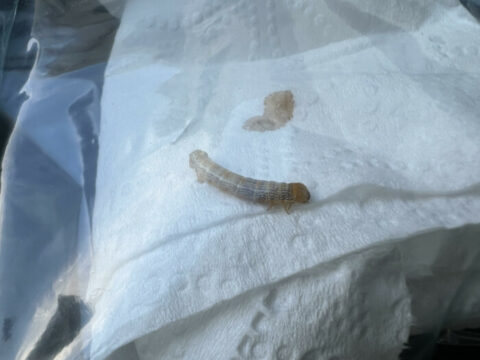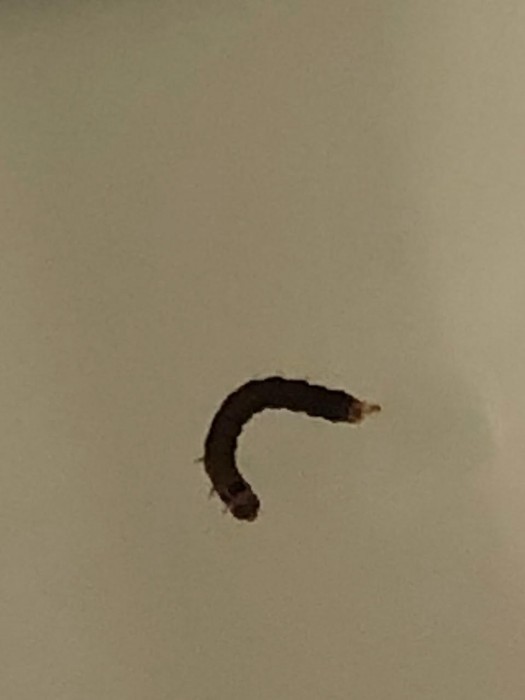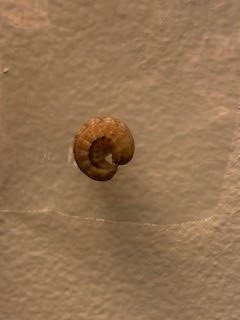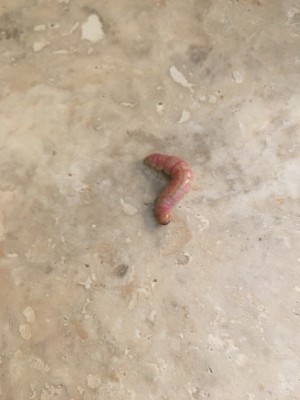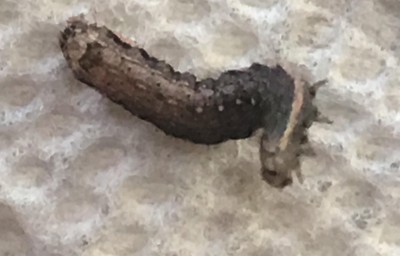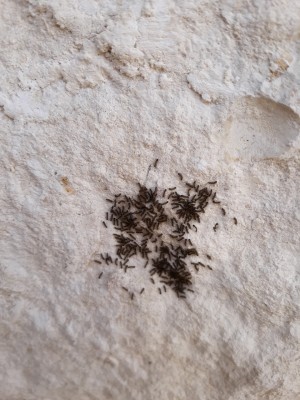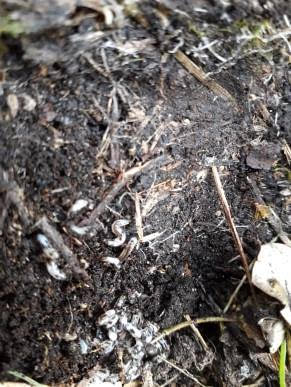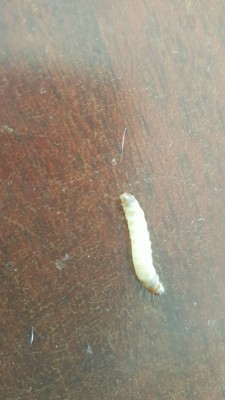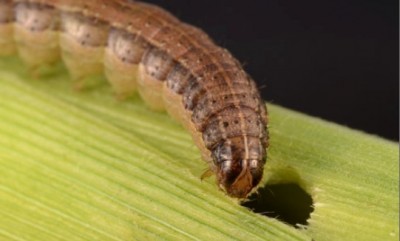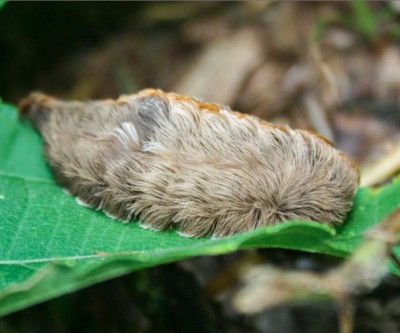Tag: caterpillar
Yellow and White-striped Worm is a Caterpillar or a Sawfly Larva
“Can you please help identify this worm?” asks this reader in their submission regarding the white and yellow-striped worm-like critter pictured below. “Thank you. I really appreciate it.” Well first off, we want to say thank you to our reader for sending in this great photo! To us, this looks like a caterpillar of some kind, though we are not entirely sure what species of caterpillar it is. It could also be a sawfly larva, which are often mistaken for caterpillars. What we will say is that we recommend that our reader avoid direct physical contact with the creatures, since we do not know what they are. Allergic reactions can occur with unknown species. We do not think it is highly likely with this caterpillar, as typically poisonous caterpillars possess bristles, but that is not always a given.
White Worm Crawling on Shoulder is a Caterpillar or Maggot
“I just saw this worm crawling on my shoulder”, writes Mackie about the white organism pictured below. “Do you know what kind of worm this is and where it possibly came from?” She does not provide more context than this, and we have to say that this worm really could be anything. Its shape, coloration, and overall appearance is so generic that it could be any number of different creatures. Our best bet is that it is a caterpillar or a maggot, but it could very well be a beetle larva too, or something else entirely. Whatever it is, we think it probably ended up on Mackie’s shoulder when she was outside: it likely fell out of a tree and landed on her.
White Worm with Brown Head is a Caterpillar Pest
“Can you tell me what this is?” is all this reader asks in her submission regarding the cream-colored, worm-like creature pictured below. Now, since we can only go on the photo our reader sent in, we will have to say that any identification made is not made with 100% certainty or accuracy. Especially in this case: the physical characteristics of this creature are so generic that it could be any number of things, and without the context in which the critter was found, we cannot pinpoint exactly what it could be. What we will say is that it is definitely the larva of an insect, and, assuming it was found inside our reader’s home, we would say it is likely some type of moth caterpillar, and potentially a pest at that.
Yellow Caterpillar with Black Stripes on Leg Could be a Long-tailed Skipper Caterpillar
Michelle writes to us her daughter found a caterpillar-like creature (pictured below) on her leg when walking home from the library. “She did go into one of her friend’s yards and knocked on their door: they weren’t home so she continued to walk home via the road. She didn’t go into any bushy or forested areas on the way home but found this little caterpillar thing crawling on her leg. So, we wanted to identify it and find out what kind of caterpillar or larvae it is. We did notice that it created a silk or web-like substance.” Based on the photo, we agree that this looks like a caterpillar. Unfortunately, the lighting in the photo makes it hard to see what color the caterpillar really is: we think it looks yellow, but that could also be the lighting. It could very well be a light green or gray color.
Segmented, Brown Worm in Spearmint Plant is Likely a Caterpillar
“Found in a potted Spearmint plant”, states Terri in her submission regarding the glossy, segmented, worm-like creature pictured below. “North-Eastern North Dakota. The plant was not growing very well. Wondering if this may be why.” From what we can tell, the worm in question has a clearly segmented, brown body, though we cannot see much else, and this is unfortunately the result of a blurry photograph. If the photo were clearer, we might be able to make out if the caterpillar has legs, or if it has any other distinguishable markings that would set this critter apart from other worm-like organisms.
Segmented, Black Worm-like Critter with Spiky Rear and Huge Eyespots is Likely a Caterpillar
“What is this worm?” asks this reader about the segmented, black worm-like creature pictured below. “I can’t seem to find it on Google or anywhere. In another article, you described it as an intermediate hooded owlet moth caterpillar, but after examining the images it’s the same thing I found, and in person you can tell it’s not really a caterpillar.”
Bright Yellow/Green Worm Found on Cat’s Food Bowl is Indeed a Caterpillar
“I was cleaning my room and found this particular caterpillar (I think) on my cat’s food bowl”, writes this reader about the yellow creature below. Our reader asks that we tell him if his cat has worms or if it is possible that the organism came in from the outdoors.
Dark Brown Worm Found in Toilet is a Caterpillar
“I found this strange-looking, dark brown worm in my toilet, just floating there,” states this reader about the organism pictured below. She thinks it was already there before she used the toilet, and she asks if we know what the creature is.
Yellowish Caterpillar Could Be an Armyworm, or Something Else Entirely
“Located in central PA and can’t figure out what this worm is I just found on my floor,” says this reader in her one-line submission. The worm in question appears to be a yellowish color, with a segmented, semi-transparent body and dark-brown stripes running down its sides.
Black and White-Striped Caterpillar with Brown Head is a Striped Garden Caterpillar
“What is this?” is all this reader asks about the brown-headed, black and white-striped worm-like creature he found in the photograph below. In this article, we will do our best to tackle this profound question.
Brown Worm in Toilet is an Eastern Tiger Swallowtail Butterfly Caterpillar
A woman in Maryland found this worm swimming in her mother-in-law’s toilet and hopes that we can help ID the critter. The worm in questions appears to be a mottled brown color, with a segmented body and a yellow band near its head, as well as a pair of eye spots just below the stripe.
Unidentified, 1/2-inch Caterpillar Finds its Way Into A Glass of Water
A 1/2-inch worm was found in a glass of water by this man in Albuquerque, NM. From the excellent images sent in, we can see that the worm in question is of a grayish/tan color, is segmented, has six forelegs, eight back legs, and a bulbous black head.
Cluster of Eggs in Cotton-Like Webbing are Fall Armyworms
A patch of “cotton-looking structures” were found attached to the brick outside of this reader’s front door. Our reader wonders what “brand of creature” these may be, which appear to be as white in color as the cotton-like webbing they were found in.
Pink Worm in Phoenix is a Palm Flower Caterpillar
A reader of ours from Phoenix, Arizona recently sent in this image of a species of worm she has been finding once a day, in or near her hall bathroom. The worm appears pink in color, with a white underside, and is segmented with multiple sets of legs.
Worm Caught Eating Dahlia Leaves is a Caterpillar
A reader recently sent in this image of a black worm-like creature he caught eating dahlia leaves. He asks that we identify the creature, which is 1cm (0.39-inches) in length, black and gray in color, and with a white stripe down the middle of its underside.
Cluster of Larvae Discovered on Limestone
Our reader discovered a cluster of moth larvae on the limestone wall of her house. She can wash her walls to get rid of these creatures, but they are nothing to be worried about!
Clusters of Worms Found in Garden Under Stones
Today we will discuss some worm-like organisms that a reader discovered under stones in her garden. She wrote that she keeps finding large clusters of them and is curious about what they are.
Hundreds of White Worms Emerge From Lemon Tree Pots
We recently heard from a reader who is quite worried about her lemon trees. She explained that in the last few months she has noticed a few worm-like organisms in her lemon tree pots, but it became a real issue after she fertilized her plants.
About the Fall Armyworm (or Fall Army Worm) and Beet Armyworm (Beet Army Worm) Infestation
The “wanted dead or alive” outlaws of the worm world are currently two caterpillars that are causing some serious issues around the world. The Fall Armyworm has eaten its way through Africa and is now spreading through Asia, destroying maize crops and leaving farmers in economic distress. The Beet Armyworm population is predicted to spike in England, causing similar issues for onion and scallion crop farmers there.
Adorable Yet Dangerous…Introducing the Asp Caterpillar
We have written articles about caterpillars that look like sticks and caterpillars that look like snakes. We have identified caterpillars that are marked with beautiful colors and intricate patterns and caterpillars that are covered in crystals. This article will be about a caterpillar that resembles a hairpiece!
